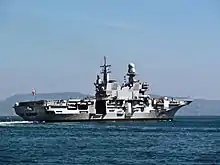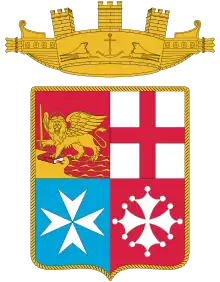Italian aircraft carrier Cavour
Cavour (Italian: portaerei Cavour) is an Italian aircraft carrier launched in 2004. She is the flagship of the Italian Navy.
.jpg.webp) Cavour | |
| History | |
|---|---|
| Name: | Cavour[1] |
| Namesake: | Camillo Benso, conte di Cavour |
| Ordered: | 22 November 2000 |
| Builder: | Fincantieri |
| Cost: | €1.39 billion (2010) |
| Laid down: | 17 July 2001 |
| Launched: | 20 July 2004 |
| Commissioned: | 27 March 2008 |
| In service: | 10 June 2009 |
| Homeport: | Taranto |
| Identification: | Pennant number: 550 |
| Motto: | In arduis servare mentem |
| Status: | Active |
| General characteristics | |
| Type: | Aircraft carrier |
| Displacement: | 27,100 metric tons (26,700 long tons)[2] (30,000 MT full load)[3] |
| Length: | - 244 m (800 ft 6 in) LOA[4] |
| Beam: |
|
| Draught: | 8.7 m (28 ft 7 in) |
| Propulsion: |
|
| Speed: | +29 knots (54 km/h; 33 mph) (Max sustained speed, 85% MCR) |
| Range: | 7,000 nmi (13,000 km; 8,100 mi) at 16 knots (30 km/h; 18 mph) |
| Complement: |
|
| Sensors and processing systems: |
|
| Electronic warfare & decoys: |
|
| Armament: |
|
| Aircraft carried: |
|
| Notes: | 4 LCVP |
Design
_-_Harry_S._Truman_(CVN-75)_and_Charles_de_Gaulle_(R91)_underway_in_2013.JPG.webp)

The ship is designed to combine fixed wing V/STOL and helicopter air operations, command and control operations and the transport of military or civil personnel and heavy vehicles. The 134 m (440 ft), 2,800 m2 (30,000 sq ft) hangar space can double as a vehicle hold capable of holding up to 24 main battle tanks (typically Ariete) or many more lighter vehicles (50 Dardo IFV, 100+ Iveco LMV), and is fitted aft with access ramps rated to 70 tons, as well as two elevators rated up to 30 tons for aircraft. Cavour can also operate as landing platform helicopter, accommodating heavy transport helicopters (AgustaWestland UH-101A ASH) and 325 marines (91 more, on option).[8] The Cavour has a displacement of 27,900 tons but can reach more than 30,000 tons at full military capacity.[2]
It complements the Italian navy's other aircraft carrier, the Giuseppe Garibaldi.
The Italian Navy will replace its 16 Harriers with 15 (originally 22) Lockheed Martin F-35B Lightning IIs.[9] By May 2020, the modernization to allow Cavour to support the F-35B was completed, and the carrier was ready for subsequent integration trials. Cavour will have room for ten F-35Bs in the hangar, and six more parked on deck.[9]
Construction
Cavour was laid down by Fincantieri in June 2001, and was launched from the Riva Trigoso shipyard in Sestri Levante, on 20 July 2004.[11] Sea trials began in December 2006, and she was officially commissioned 27 March 2008. Full operational capability (FOC) was reached 10 June 2009.
Service history
On 19 January 2010, Cavour was dispatched to Haiti as part of Operation White Crane, Italy's operation for 2010 Haiti earthquake relief.[12] This was the first mission of the aircraft carrier, where it supplemented international efforts to provide relief for the victims of the 2010 Haiti earthquake.[13]
It is reported that modernization works on the Cavour has been completed. In May 2020, it was announced the Italian aircraft carrier will undertake a preparatory training before sailing to the U.S. where the ship will conduct trials with the F-35B STOVL.
See also
References
- "Cavour – Marina Militare". Marina.difesa.it. Retrieved 12 December 2016.
- "The world's largest and most powerful aircraft carriers, in pictures". 23 March 2015 – via www.telegraph.co.uk.
- "The 10 biggest aircraft carriers – Naval Technology". 5 July 2017.
- "Cavour Class". Fincantieri.com. Retrieved 12 December 2016.
- "Finmeccanica on board of Cavour – DETAIL – Finmeccanica Naval Capabilities". finmeccanica.com. Retrieved 18 January 2016.
- "Griffon Subsidiary Announces $3.6 Million Contract Award from Italian Navy for Aircraft Carrier Landing System; Telephonics Continues Expansion into European Markets". Business Wire. 13 September 2004. Retrieved 12 December 2016.
- "Cavour Aircraft Carrier, Italy". Naval-technology.com. Retrieved 1 January 2015.
- http://www.marina.difesa.it/conosciamoci/editoria/marivista/Documents/2010/07_lug/Cosentino.pdf
- Nativi, Andy; Menon, Jay; Sweetman, Bill (5 April 2012). "Navies Worldwide Invest In Sea-Based Airpower". Aviation Week.
- "Italian Navy Launches Conte di Cavour-Class Carrier". Sea Power. 1 September 2004. Archived from the original on 24 September 2015. Retrieved 23 June 2015 – via HighBeam Research.
- "Photostory: Portaerei Cavour, gli aiuti per Haiti" (in Italian). ANSA. 4 February 2010. Retrieved 1 January 2015.
- "La portaerei Cavour pronta a partire per Haiti" (in Italian). la Repubblica.it. Retrieved 1 January 2015.
Sources
- Cosentino, Michael (2014). "Cavour: A Multi-Role Aircraft Carrier for the Italian Navy". In Jordan, John (ed.). Warship 2014. London: Conway. pp. 93–111. ISBN 978-1-84486-236-8.
External links
- Cavour on the Marina Militare website (in Italian)
- History, technical details and a collection of photo of Cavour
| Wikimedia Commons has media related to Cavour (550). |
